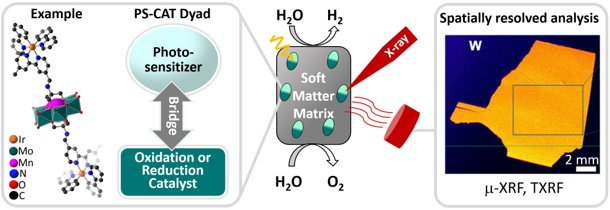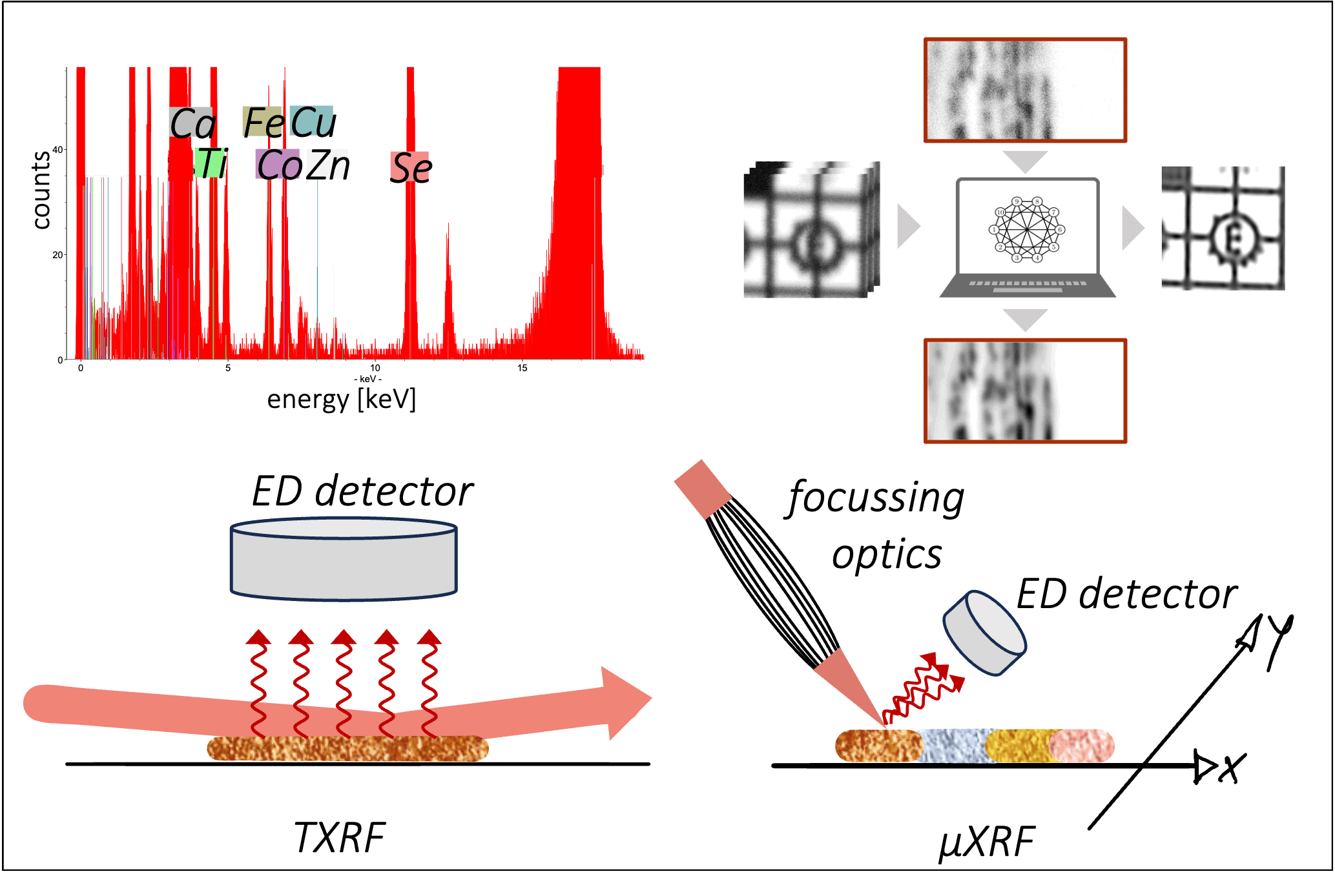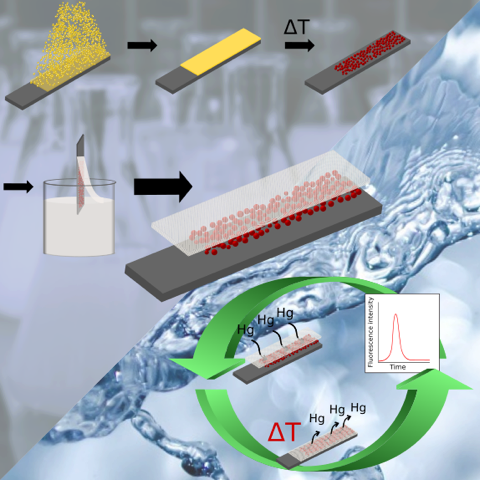Research Group Leopold
Research Interests
The development of analytical methods for trace and ultra-trace analysis of elements, element species, and nanoparticles under clean room conditions is in focus of our research. This includes also distribution analysis, element mapping, study of migration and bioavailability of elements and nanoparticles that are relevant in environmental and biological samples. Thereby, we follow the principles of Green Analytical Chemistry aiming to provide more sustainable analytical procedures. For this purpose, we develop new direct analysis methods using various atomic spectrometry techniques, such as atomic absorption spectrometry (AAS), total reflection X-ray fluorescence spectrometry (TXRF), micro-X-ray fluorescence spectrometry (µXRF). In addition, where preconcentration is required, we develop solid phase extraction techniques (SPE) based on recyclable materials that can be combined with automated flow injection analysis systems (FIAS) and coupled to atomic fluorescence spectrometry (AFS), atomic emission spectrometry (AES) or other detection systems. Furthermore, nanomaterials play an important role – both, as tool to enhance analysis and as target analytes. Our research projects always include validation and application to real world samples coming from environmental, biological, medical or energy research and application. Therefore, interdisciplinary cooperation is most valuable and many of our projects are collaborative work.
Current Topic: Metal nanoparticle analysis
MNPs are nowadays widely used and represent a new kind of challenging analytes in product quality control, medical research, as well as in food and environmental analysis. For the later, low concentrations in combination with very complex matrices pose problems to the analytical chemist. In particular, standard sample pretreatment techniques for trace analysis fail in the investigation of MNPs, since unintended size changes are often observed. Therefore, no robust and valid methods for detection and characterisation of MNP in complex samples are established at presence. Our research strategy therefore aims at a direct detection and size characterisation of NP in complex matrices, i.e. without sample pretreatment using high-resolution continuum source graphite furnace atomic absorption spectrometry (HR-CS-GFAAS). Recently we have introduced a unique approach to detect and characterise silver and gold nanoparticles by HR-CS-GFAAS applying a novel strategy for interpretation of signals. This method has the potential to solve the analytical problems involved with standard sample pretreatment methods and enables to distinguish metal ions from metal nanoparticles at low concentrations in complex matrices.
Current and recent projects:
- DFG - MiNaPla - Analysis of Micro- & nanoplastics and engineered Nanoparticles in human Placenta (MiNaPla) in cooperation with Dr. Sophia Andres (Ulm University Hospital) and Dr. Natalia Ivleva (Technical University Munich)
- DFG - AASS Atomic Absorption Spectrometry for Sizing nanoparticles
- Evaluation of the atomisation mechanism of metal nanoparticles in GFAAS in cooperation with Prof. Dr. R. Güttel and Dr. Jens Friedland, Institute of Chemical Engineering, UUlm
- DFG - DiDeSiNa Direct Detection of Silver Nanoparticles in biological and environmental samples
Current Topic: Trace bio-metal analysis
Trace elements are essential for life and many trace metals have been identified to play a crucial role in diseases like cancer or Alzheimer. In order to achieve a better understanding of their homeostasis and involvement in diseases as well as to find potential new diagnostic tools, the development of novel and enhanced methods for trace analysis of these metals in biological and medical samples is important. This includes amongst others the provision of analytical methods for trace metal determination in minute sample amounts and analysis of tissues or cells with lateral resolution (element imaging). For this purpose, we are developing new methods applying total reflection fluorescence spectrometry (TXRF) for multielement trace determination and micro-X-ray fluorescence spectrometry (µXRF) to provide laterally resolved information.
Current and recent projects:
- DFG - MiNaPla - Analysis of Micro- & nanoplastics and engineered Nanoparticles in human Placenta (MiNaPla) in cooperation with Dr. Sophia Andres (Ulm University Hospital) and Dr. Natalia Ivleva (Technical University Munich)
- SuperResXRF - Super resolution techniques in micro-X-ray fluorescence spectrometry
in cooperation with Prof. Dr. Henning Bruhn-Fujimoto, Institut für Optimierung und Operations Research, UUlm - Enhancing iron trace analysis in biomedical research using TXRF
in cooperation with Prof. Dr. Maja Vujic Spasic, Institut für Molekulare Endokrinologie der Tiere, UUlm - Investigation of engineered nanoparticles in human placenta
in cooperation with Dr. med. Sophia Andres, Uniklinik Ulm

Current Topic: Distribution analysis of catalytically active elements in new soft matter materials
CataLight project has the vision to design artificial chloroplasts using knowledge-guided design concepts for light-driven coupled oxidation and reduction catalysis in compartmentalized reaction spaces. For this purpose, hierarchically structured soft matter matrices for molecular component integration are developed. Thereby, the distribution of the matrix embedded catalysts and photosensitizers as well as their stability within the matrix are basic questions in characterisation and further optimisation of these systems. In this field, our group contributes by developing new methods to provide qualitative and quantitative information on element distributions (element imaging) and stability in matrix. Here, we apply the X-ray fluorescence spectrometry techniques µXRF and TXRF as well as direct solid sampling GFAAS.
Current and recent projects:
- “POMbranes” – Incorporation of catalytically active polyoxometalates into integral asymmetric block copolymer membranes – Project B03
in cooperation with Prof. Dr. Carsten Streb, Inorganic Chemistry, Johannes Gutenberg Uni Mainz and Prof. Dr. Felix Schacher Organische Chemie und Makromolekulare Chemie, Friedrich-Schiller-Universität Jena, funded by DFG in SFB/Transregio 234/2 CataLight

Current Topic: Element analysis in post Lithium battery materials using atomic and X-ray spectrometry
The POLiS Cluster of Excellence aims to provide new sustainable materials and manufacturing processes for long-lasting and safe batteries of the next generation. Comprehensive analytical characterization is in this regard key to a deeper understanding of their functionality and allows knowledge-based development of novel materials and systems. Chemical composition analysis complements theoretical and experimental studies on electrochemistry, structure formation and morphological changes. Thereby, (trace) element analysis for quantitative and spatially resolved element analysis are important. Here, we aim to develop advanced analytical methods for the quantification and distribution of main charge carriers and other metals in high-potential new electrode materials and electro- lytes using atomic and X-ray spectrometric techniques. This will help to understand cell performance, deposition of elements on electrodes and separators, and degradation processes.
Current and recent projects:
- “Advanced analytical methods for battery material characterization” – Project in Post Lithium Storage Cluster of Excellence; funded by the Deutsche Forschungsgemeinschaft (DFG, German Research Foundation) under Germany’s Excellence Strategy - EXC 2154


Current Topic: Mercury Trace Analysis
Mercury is an increasing and persistent pollutant and is due to its high mobility globally distributed in our environment. Because of its high toxicity it requires monitoring in all environmental compartments, however, it is particularly important in the hydrosphere, where mercury bio-accumulates up to a million times in the aquatic food chain. Mercury concentrations in natural waters are typically in the sub to low ng L-1 range and extremely sensitive detection techniques are required to obtain reliable analytical data. Our research in this field yields at enhancing the analytical performance and at the same time providing sustainable and easy to handle in-situ and reagent-free analytical procedures on basis of nanomaterials. In recent years we have designed new solid phase extraction (SPE) materials based on gold nanoparticles that serve as catalysts for degradation of mercury species and at the same time as selective adsorbers for mercury traces by amalgamation. This preconcentration technique is highly efficient and selective and can be coupled to several atomic spectrometry detection technique achieving extremely low detection limits of a few fg absolute.
Current and recent projects:
- NanoTeHg Developing new Nanogold-based Test Strip for Environmental and Bio-Monitoring of Mercury (Hg) Traces
in Cooperation with Prof. Dr. Mika Lindén, Inorganic Chemistry UUlm - Enhancing speciation analysis of mercury by combining SPE preconcentration and chromatographic separation techniques


